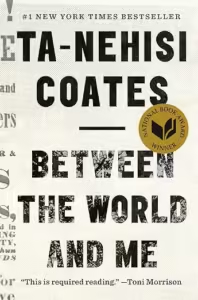Between the World and Me
Ta-Nehisi Coates
Spiegel & Grau
Published July 14, 2015
Amazon | Bookshop | Goodreads
About Between the World and Me
“This is your country, this is your world, this is your body, and you must find some way to live within the all of it.”
In a profound work that pivots from the biggest questions about American history and ideals to the most intimate concerns of a father for his son, Ta-Nehisi Coates offers a powerful new framework for understanding our nation’s history and current crisis. Americans have built an empire on the idea of “race,” a falsehood that damages us all but falls most heavily on the bodies of black women and men—bodies exploited through slavery and segregation, and, today, threatened, locked up, and murdered out of all proportion. What is it like to inhabit a black body and find a way to live within it? And how can we all honestly reckon with this fraught history and free ourselves from its burden?
Between the World and Me is Ta-Nehisi Coates’s attempt to answer these questions in a letter to his adolescent son. Coates shares with his son—and readers—the story of his awakening to the truth about his place in the world through a series of revelatory experiences, from Howard University to Civil War battlefields, from the South Side of Chicago to Paris, from his childhood home to the living rooms of mothers whose children’s lives were taken as American plunder. Beautifully woven from personal narrative, reimagined history, and fresh, emotionally charged reportage, Between the World and Me clearly illuminates the past, bracingly confronts our present, and offers a transcendent vision for a way forward.
My Review
I listened to an audiobook version of this book that was read by the author. It’s a pretty short book, only about 150 pages divided into three chapters. The first two are much longer than the third chapter.
This is Coates’ letter to his son, and it’s about his experience as a young Black man and his thoughts and experiences about becoming a father to a Black son. While this was published in 2015, it could have been written today. Everything in these pages feels just as relevant today as it did almost ten years ago.
One of the things that the author talks about is his relationship to history and education. Some of the ways he describes his interest in or quest to learn more about history really resonated. He talks about wanting history to have one cohesive narrative in which historians agree, and that instead, he found the opposite: lots of voices with different takes on historical events and their significance.
He also talks about realizing that we simplify historical figures into something that we want them to be. This doesn’t allow room for who they truly were because it removes part of their stories. I want to reread that passage in particular because it’s so true, and he says it so well.
Coates also talks about someone he knew in college whose life was cut short when he was killed by a police officer. He returns to this story several times through the book. Again and again he talks about the idea that in this world, safety means having control of your body. And there are situations in which he does not have a guarantee of that control, including in encounters with police.
He refers to “people who think they are white” many times, which I think comes from a quote attributed to James Baldwin. That gave me some food for thought as well, as it really highlights the made-up-ness of race and the self-assigned value of whiteness. Again, a really concise way to say a big idea, something the author does really well.
Overall, this book delivered a lot of ideas that I want to let percolate. I loved reading this vulnerable, wise letter from a father to his son. It makes sense that this one got the awards and acclaim that it has. It’s definitely worth reading.
Content Notes
Recommended for Ages 14 up.
Profanity/Crude Language Content
Includes use of the N-word very infrequently.
Romance/Sexual Content
Reference to falling in love, getting married, and having a child.
Spiritual Content
Coates himself does not believe in God, but he references others that do and the power of that belief in others’ lives.
Violent Content
References to racist comments. Vague references to street fights. References to police violence and death at the hands of a police officer.
Drug Content
None.
Note: This post contains affiliate links, which do not cost you anything to use but help support this blog. All opinions are my own.
